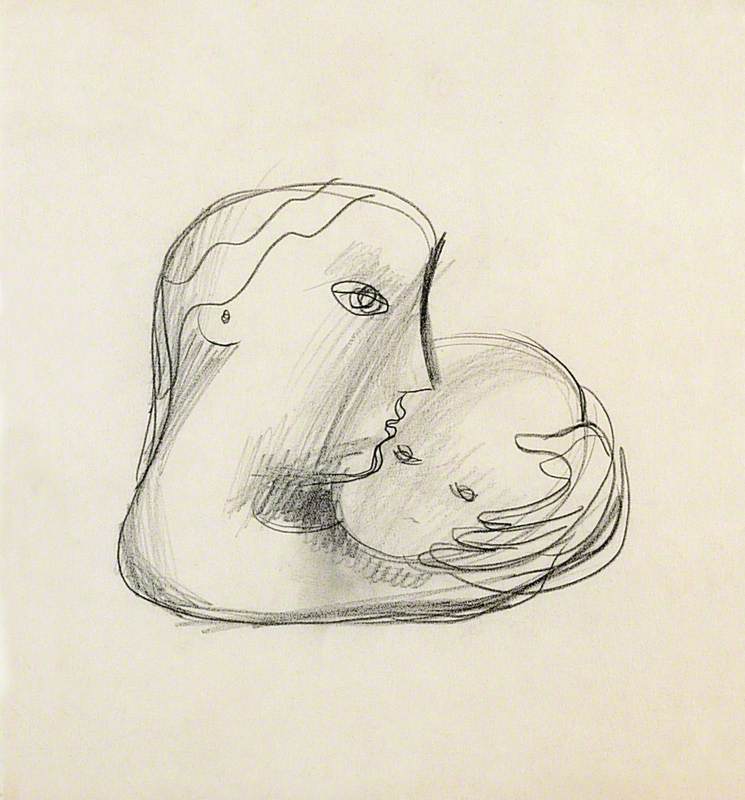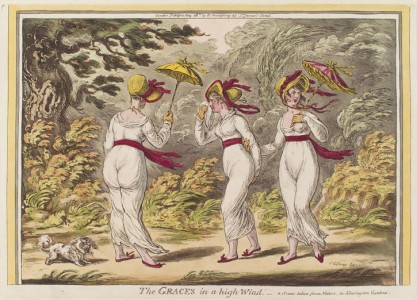The exhibition 'Picturing Childhood: A New Perspective' at Chatsworth House focuses on children's portraiture over the centuries. Artworks through the ages reflect shifting perspectives in how children were perceived and valued by society – and their clothing in particular act as markers which we can read to identify a child's socio-economic status, gender and influences.
The Painter's Daughters chasing a Butterfly
probably about 1756
Thomas Gainsborough (1727–1788) 
What is the difference, for example, between the 1575 portrait of James I as a child by Arnold Bronckhorst and Naomi Archibald's 2010 painting Protector? Separated by more than 400 years, the two paintings have striking similarities, from the cropped compositions, the turned positions, the children's rosy colourings, and their amiable expressions.
James I wears a bejewelled, black velvet cap with feathers, a lace ruff and a decorative, slashed doublet embellished with gold thread. As a monarch, he had access to the finest materials and makers. His clothing choices were not inhibited by the sumptuary laws that restricted the clothing options of the social tiers below him – laws which he would later abolish in 1604 when he was king.
In contrast to James' royal regalia, the child in Protector wears a simple blue buttoned shirt with green patches. Today's viewers could expect to see a top like this in a high-street store. The clothing informs how we view the sitters: James I's attire elevates his status with the aim of legitimising his rule, whereas the everyday shirt makes the child in Protector familiar and relatable.
Looking at children's clothing through the lens of art does not give the truest representation of what children wore. Apart from images of the infant Christ or John the Baptist, there are few representations of children before 1500. When they are depicted, they are usually part of a family group, which were gathered and recorded to reflect the significance and legacy of the head of the family who commissioned the artwork.
George (c.1531–1585), 5th Lord Seton, and his Family
1572
Frans Pourbus the elder (1545–1581) 
An example of this is George, 5th Lord Seton, and his Family (1572) by Frans Pourbus the elder, in which George is encircled by his four boys and daughter. The children are the physical manifestations of their father's faith, success, and legacy. The youngest child holds an open Bible reflecting the family's Catholic beliefs and allegiance to Mary Queen of Scots. The children are opulently bedecked in jewels, fur and velvet, with starched white lace ruffs. Their outfits, like their poses, are stiff and formal.
In this painting, Sir Walter Raleigh is pictured standing next to his eldest son. The adolescent boy is a diminutive copy of his father in his pose and outfit of lace collar, doublet, breeches, stockings and sword.
In the sixteenth and seventeenth centuries, boys adopted this miniature form of male clothing once they left their mother or nurse's care and entered school, an apprenticeship or the army. Up to this point, children were dressed – like the women in the household – in tunics, gowns or skirts, as shown in the below work from 1608 by Marcus Gheeraerts the younger. Dressing all infants in dresses was common practice until the 1960s in Britain, when clothing stopped being rationed, and infants' clothing became more gendered.
A signifier of Raleigh's son's recent graduation into the male sphere is his short hair. Boys would have their childhood locks cropped off as they moved from gowns into breeches (short trousers) in a rite of passage ceremony called breeching. In contrast to the previous work by Frans Pourbus the elder, the child's presence in this painting is purposeful. The boy stares directly out of the painting, challenging the viewer and asserting his right to be there, as well as making clear his role as his father's successor.
There is, however, no sense of familial affection or any naturalism captured in the portrait of Raleigh and his son, unlike that of the Family of Jan Brueghel the Elder (1613–1615) by Peter Paul Rubens. The purpose of Ruben's painting is not to assert lineage but to capture a relaxed and tender interaction between the parents and their children.
Family of Jan Brueghel the Elder
1613–1615
Peter Paul Rubens (1577–1640) 
In this painting, the young girl holds her mother's hand while the boy toys with her bracelet. The girl is wearing a silk brocade bodice with leading strings. These were similar to today's toddler reigns, used to support a child as they learn to walk. At this time, they also symbolised a girl's dependence and obedience to her family. She also has a string of coral around her neck, which was used as a teething aid.
The boy wears a silk decorative doublet with a row of expensive brass buttons down the front, indicating that he can dress himself, and is in contrast to female clothing which fastened at the back and required assistance. The boy is slightly older than his sister and is out of short gowns. Short gowns, depicted on a young Charles II below, were dresses, usually white in colour, which were worn by young boys and girls until they were toilet trained.
A print from the mid-1800s by the French artist Jean-François Millet is a wonderful example of why all infants wore short gowns – they could be pulled up to make going to the toilet much easier. It also highlights how portraiture featuring children changed over the centuries to incorporate intimate family routines.
The Maternal Precaution
1850–1860s, cliché-verre on paper by Jean-François Millet (1814–1875) 
Having a portrait painted was costly, time consuming and the reserve of the wealthy. In Johann Zoffany's 1786 painting Colonel Blair with his Family and an Indian Ayah, we see the portly Colonel, who served in the Bengal army in colonial India, surrounded by the sumptuous flowing silk gowns of his female relatives. The girls' tight bodices, pastel-coloured full-skirted gowns and silk straight shoes are sharply juxtaposed with the vibrant red-and-gold scarf of the barefoot young Indian ayah (nursemaid), with her loose tunic and baggy traditional dhilja trousers.
The intentional inclusion of the young ayah, who is from a different culture and social class, could have been to ground the work in Calcutta and to mark the family's acclimatisation to India. Zoffany may have been instructed to include her as she was a valued extension of the Blair family. Another reading is that she represents the Blair family's benevolence to 'outsiders', echoing colonial sentiment within the British Empire whereby foreign domestic staff were, as academic Priyamvada Gopal makes clear, considered 'exotic status symbols for new Nabobs flush with East India Company wealth'.
The ayah's presence in this painting provides a rare insight into what young, female domestic workers were wearing at this time during British colonial rule in India, as well as hinting at wider resistance among the colonised in adopting European dress.
In the eighteenth century, artists such as John Opie sought to depict children on the lower social stratum. In The Peasant's Family (c.1783–1785), the children's clothes are simple. The female trio wear full skirts over simple white shifts, which show signs of wear and tear. The youngest girl is barefoot, and the other wears leather clogs, which would have been typical footwear for families involved in agriculture.
The young girls wear stays (a softer version of a corset) under their bodices, which would have restricted their movements and cinched in their waists to create a more hourglass silhouette. The use of foundational garments in the form of laced-up corsets, stays, liberty bodices or elasticated roll-ons spans more than 400 years, beginning in the sixteenth century and continuing until the mid-twentieth century.
From birth, babies' stomachs were wrapped with binders to support their bodies – made clear in this portrait of The Saltonstall Family – and then later, infants were strapped with corded cotton stays. As they progressed through childhood, boys could escape stays as they moved into breeches, but young girls were not so lucky and moved into the tighter and stiffer corset. An example of this can be found in Dr Samuel Walthen with His Wife and Children (1755) by George Knapton.
Dr Samuel Walthen with His Wife and Children
1755
George Knapton (1698–1778) 
In Portrait of a Boy in a Top Hat with Flies from the late eighteenth century, another of Opie's works depicting poorer children, the boy's jacket is scuffed at the elbow and his hand is caked with grime.
Opie's choice of warm ochres for the girls' gowns in The Peasant's Family and the flamboyant feather encircling the boy's top hat here add richness and texture to their attire. Set against the dramatically lit natural backdrops, Opie elevates these children and romanticises their everyday tasks of seeking out food and water.
As we move through the centuries, we see attitudes towards children warming, with clothing and representation becoming less rigid and more self-expressive. The skeleton suit from the 1790s (seen below), a two-piece outfit for young boys consisting of trousers and a fitted short jacket, is an example of more comfortable clothing. It is also one of the first examples of specially designed childrenswear, in contrast to earlier centuries when infants were dressed as miniature adults.
Whether looking at a sixteenth-century painting or a contemporary school photograph, the clothing children wear speaks volumes about them and their lifestyles. Clothing is packed with signifiers which we read to pinpoint that child to a specific time and place. The arrival of the smartphone and the selfie has meant that childhood portraits are no longer elitist or selective; children now have the tools to curate and capture their own image.
Katy Canales, curator
'Picturing Childhood: A New Perspective' is at Chatsworth House from 16th March to 6th October 2024
This content was sponsored by the Samuel H. Kress Foundation
















































